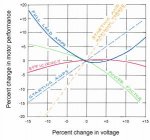Forum,
I've read about the 10% rule for overvolting motors, and the question I had is does this 10% rule apply to the nameplate voltage of the motor, or the nominal system voltage?
For example, motors rated at 460v (system nominal of 480v), running off of a transformer supplying 495 volts:
460 x 1.10 = 506
480 x 1.10 = 528
Quite a difference in the two scenarios...let me know, thanks!
I've read about the 10% rule for overvolting motors, and the question I had is does this 10% rule apply to the nameplate voltage of the motor, or the nominal system voltage?
For example, motors rated at 460v (system nominal of 480v), running off of a transformer supplying 495 volts:
460 x 1.10 = 506
480 x 1.10 = 528
Quite a difference in the two scenarios...let me know, thanks!

